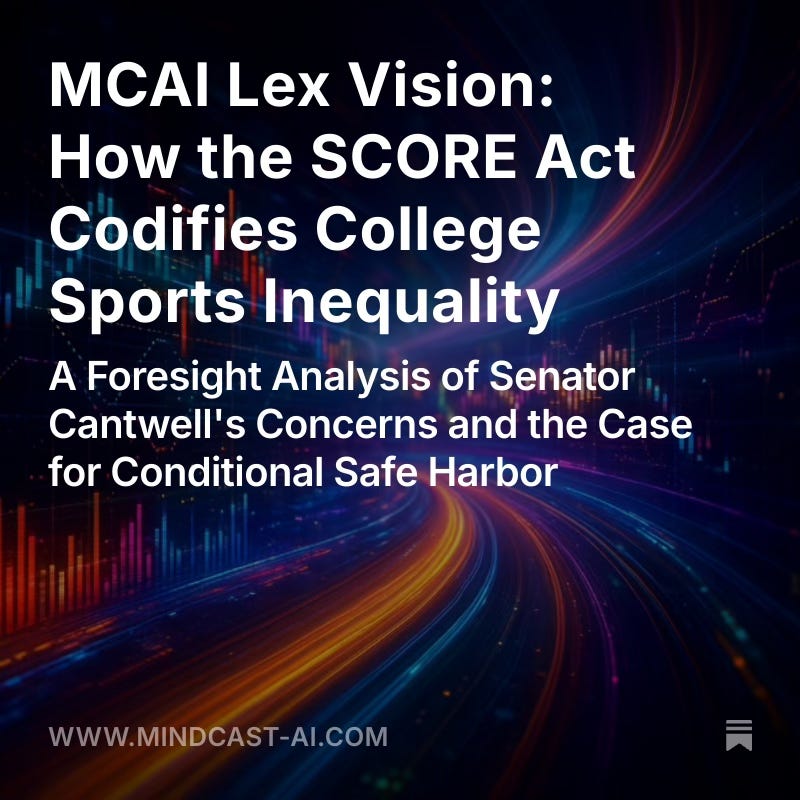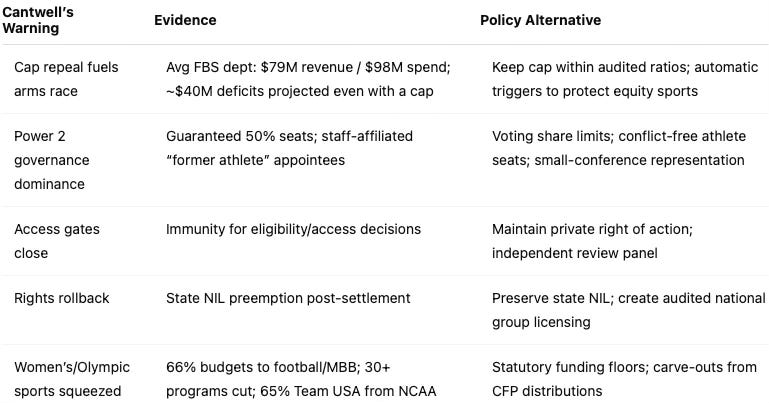MCAI Lex Vision: How the SCORE Act Codifies College Sports Inequality
A Foresight Analysis of Senator Cantwell's Concerns and the Case for Conditional Safe Harbor
I. Preface
MindCast AI Foresight Statement
The publication demonstrates how MindCast AI applies foresight simulation to law and policy. In a letter to over 350 universities, Senator Cantwell has sounded the alarm about the SCORE Act, but warnings alone are not enough. Our approach projects how legislation behaves once enacted—how budget deficits, playoff access, and athlete rights evolve under the weight of federal immunity. By comparing Cantwell’s concerns, evidence, and policy alternatives, we show how today’s decisions become tomorrow’s structures. The analysis offers predictive insight that turns foresight into legislative design.
MindCast AI develops foresight publications that analyze how legal, economic, and institutional forces reshape college sports. Previous work has traced the dismantling of amateurism (Alston, House v. NCAA), the concentration of media rights (Pac-12 collapse, SEC/B1G consolidation, ACC’s 60% split), playoff revenue disparities, and pressures on women’s and Olympic sports. We also studied how state-level NIL innovation empowered athletes and how institutional responses shaped risk. Together, these reports created a baseline for understanding where college athletics is headed.
The report adds a missing layer: Congress itself. By granting the NCAA broad antitrust immunity, the SCORE Act would not only ratify current disparities but lock them into federal law. It is the first study where congressional intervention becomes the primary driver of consolidation. What began in the courts and conferences is now moving to Capitol Hill.
Contact mcai@mindcast-ai.com to partner with us on antitrust compliance.
II. Senator Cantwell’s Warning
On August 25, 2025, Senator Maria Cantwell (D-WA) wrote to more than 350 Division I leaders warning that the SCORE Act would widen inequities, roll back athletes’ rights, and entrench a Power 2 duopoly of the SEC and Big Ten. She identified risks including repeal of the 22% revenue cap, governance capture, and loss of judicial recourse for excluded schools. Her letter also highlighted likely harm to women’s and Olympic sports, where funding would be squeezed as football spending accelerates. By putting these arguments in a public forum, Cantwell made clear that the bill codifies consolidation rather than reform.
Her warning provides the political anchor for this analysis. The letter highlights the urgency of examining how the SCORE Act would play out once enacted. Where her letter raises concerns, our modeling shows how they evolve into lasting structural lock-ins. Taken together, her warning and the analysis form a full picture of what is at stake.
III. Key Findings
The SCORE Act may look like a technical adjustment, but its downstream impact is sweeping. Our analysis shows how specific provisions interact with existing disparities, creating a system that advantages a few while weakening opportunities for most athletes and schools. Each finding demonstrates how legislative design can harden inequities unless conditions are imposed.
Federalized Market Concentration: The SEC and Big Ten’s dominance becomes codified in statute, with immunity making their control permanent rather than contested.
Hardened Access Barriers: Smaller programs lose judicial avenues to challenge exclusion from the College Football Playoff and television revenues, leaving competition subject only to internal NCAA decisions.
Equity Risks Multiply: Existing disparities—Pac-12 schools losing ~63% of media revenue, ACC payouts tied to viewership, and CFP distributions 10× larger for SEC/B1G—become legally entrenched, accelerating program deficits and cuts to non-revenue sports.
Athlete Rights Rollback: Preemption of state NIL laws erases hard-won gains, leaving players without leverage over compensation structures and media distribution rights.
Conditional Safe Harbor Alternative: A better path exists where immunity is tied to fairness benchmarks such as open access, revenue protections for Olympic sports, independent athlete governance, and periodic review.
These findings show that the SCORE Act is not a stabilizing measure but a codification of imbalance. Schools outside the Power 2, athletes seeking fair compensation, and communities relying on Olympic programs all stand to lose. Without conditions, inequity becomes law.
IV. Conditional Safe Harbor
Antitrust immunity should not be an open-ended privilege. Properly designed, it can provide stability while requiring measurable commitments to equity and fair competition. A conditional safe harbor approach would make immunity contingent on clear standards and periodic review, preventing consolidation from becoming permanent.
Key safeguards include:
Open CFP Access: Guarantee objective qualification rules and reserved at-large berths for all conferences, ensuring pathways for schools beyond the Power 2.
Funding Floors: Mandate enforceable minimum budgets for women’s and Olympic sports to protect broad-based participation regardless of financial pressures.
Athlete Rights Protections: Preserve state NIL flexibility or adopt a national group licensing system with independent audits, giving players consistent bargaining power.
Governance Guardrails: Limit any bloc to less than one-third of governing votes and require seats for small-conference representatives and independent athlete voices.
Sunset and Review: Time-limit immunity (e.g., five years) and condition renewal on demonstrated progress in fairness, access, and athlete welfare.
With these standards in place, antitrust protection becomes a tool for accountability rather than a shield for entrenched interests. Universities can plan with stability, athletes retain meaningful rights, and communities see Olympic and women’s programs safeguarded. Reform, in this model, is balanced, credible, and sustainable.
V. Cantwell’s Letter and This Analysis Side by Side
The alignment between Cantwell’s warning and this analysis is clear. She warned that repealing the revenue cap would fuel an arms race; the data show average FBS deficits could reach $40M annually even with a cap. She pointed to Power 2 dominance; our review shows guaranteed 50% voting control and stacked committees. She warned of rights rollback; our analysis shows NIL preemption eliminating athlete leverage after the House settlement ends.
By comparing Cantwell’s arguments, supporting evidence, and alternative proposals, we create a roadmap for reform. Policymakers can see not only why the SCORE Act is flawed but how to redesign it responsibly. The comparative framing turns critique into constructive guidance.
VI. Conclusion
Senator Cantwell has warned that the SCORE Act will roll back protections, widen inequities, and fuel a football arms race. The analysis confirms her warning and adds structured solutions. Congress now faces a choice: entrench inequity with blanket immunity or legislate accountability with conditional safeguards.
College sports are more than entertainment; they are civic infrastructure, cultural heritage, and an Olympic pipeline. Decisions made today will shape access, equity, and competition for decades. What Congress chooses now will determine whether reform means fairness or capture.
Appendix: Place in the MindCast AI Library
MindCast AI’s college sports publications now cover every major arena of influence:
“MCAI Lex Vision: Navigating the NCAA NIL Compliance Matrix, Strategic Foresight for Universities Balancing Settlement Requirements, SCORE Act Provisions, and Executive Order Pressures: A University of Washington Analysis” (July 2025) — www.mindcast-ai.com/p/uwnil. This case study examined how the University of Washington positioned itself under the NIL settlement and SCORE Act pressures, highlighting compliance fragility and governance gaps.
“MCAI Lex Vision: Foresight Simulation of the SCORE Act and NCAA Settlement: Legislative Coherence and Institutional Risk Analysis” (July 2025) — www.mindcast-ai.com/p/scoreact. That simulation stress-tested the SCORE Act under Cognitive Digital Twin loops, revealing how rigid ceilings and antitrust immunity provided clarity but eroded legitimacy over time.
“MCAI Lex Vision: Executive Foresight and the New Era of NCAA Institutional NIL Legitimacy” (July 2025) — www.mindcast-ai.com/p/ncaaeo. This analysis of the Trump Executive Order showed how federal scrutiny elevated coherence over compliance, demanding narrative integrity and foresight from universities.
Each publication added a new layer: litigation, markets, executive power, and now congressional intervention. The current report is the first to show how Congress can codify inequity. It expands the library by modeling federal law not as a backdrop but as a driver of market structure. It also introduces conditional safe harbor as a legislative design principle. Taken together, these publications provide a comprehensive view of risks and reforms in college sports.




